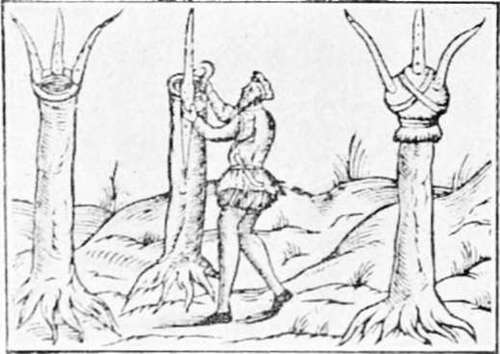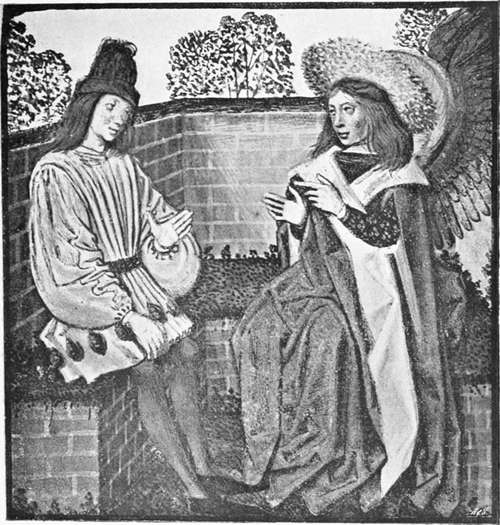Fourteenth And Fifteenth Centuries. Part 3
Description
This section is from the book "A History Of Gardening In England", by Alicia Amherst. Also available from Amazon: A History Of Gardening In England.
Fourteenth And Fifteenth Centuries. Part 3
Wardons were still the most popular of cooking varieties. In recipes for dressing pears, the wardon is usually intended; as,|| "Peris in Syrippe. Take Wardons, and cast hem in a fair potte," or, " Peris in Compost. Take pere Wardons and pare hem." At Henry the Fourth's wedding-feast, these pears in syrup occur twice, and are included in the same course as venison, quails, sturgeon, fieldfare, etc. At the coronation feast of the same king, we find quinces in " comfyte," and also " Pomedorreing" or golden apple, supposed in this case, to stand for oranges, as this rare fruit might be obtained for such a great occasion. Oranges probably were occasionally brought to this country at an even earlier date. It is said that in the eighteenth year of Edward I., the Queen bought, out of the cargo of a large Spanish ship, one frail of figs, one of raisins, one bale of dates, two hundred and thirty pomegranates, fifteen citrons and seven oranges.*
* Two Fifteenth Century Cookery Books. By T. Austin, E. E. Text Soc. † Isaac D'Israeli, Curiosities of Literature.
‡ Shakespeare—Love's Labour's Lost.—" Ripe as a Pomewater, who hangeth now like a jewel in the ear of coelo".
§ Romeo and Juliet.—•" Thy wit is a very bitter sweeting, it is a most sharp sauce".
|| Harl. MS. 4016. E. E. Text Soc.
Cherries were cultivated very extensively. The season of gathering them is spoken of by Langland as " cherry-time".
This cherry-harvest, coming at the height of summer, was a time of merry-making, and to it Gower compares the brief length of human life, which "... endureth but a throw Right as it were a cherry feast."—Confessio Amantis.
And Lydgate also uses the cherry-fair as a simile:—
" This world is but a cherry fair".
Cherries and strawberries were hawked in the streets of London, and the cry of" ripe strawberries" was familiar even in Lydgate's time.
" Then vnto London I dyd me hye Of all the land it beareth the pryse ' Hot pescodes ' one began to crye ' Strabery rype ' and ' cherryes in the ryse ' † One bade me come nere and by some spyse Peper and safforne they gan me bede.
But for lack of mony I myght not specie."—Loudon Lychpeny.
Peaches are mentioned by Lydgate among "the fruits which more common be," but only inferior varieties were in cultivation.
* Manners and Household Expenses. Ed. Beriah Botfield. Roxburghe Club, 1841.
† = branch, twig.
Medlars were also grown, and were kept before being eaten, as is still the fashion. In the Prologue to the Reeve's Talc, Chaucer refers to this custom, speaking of the old age of the Reeve :—
" But if I fare as doth an open-ers* That ilke fruit is ever lenger the wers Til it be roten in mullock † or in stre." †
In the description of the garden and arbour in The Flower and the Leaf, a medlar tree in full bloom, that " to the herber side was joyning," is thus picturesquely described :—
" And as I stood and cast aside mine eie I was ware of the fairest medlar tree, That ever yet in all my life I sie. As full of blossomes as it might be. Therein a goldfinch leaping pretile Fro bough to bough ; and as him list, he eet Here and there of buds and floures sweet".
Plums are not often mentioned, either by the poets, or in old accounts, but we know that both damsons and bullaces were grown in this country, though probably in no great quantities.
In the Romaunt of the Rose Chaucer classes them among homely fruits :—
" And many hoomely trees there were That peches, coynes,‡ and apples bere Medlers, ploumes, peres, chesteynis, Cheryse, of which many one fayne is, Notes, aleys and bolas That for to seen it was solas." (L. 1373).
Gardeners of this date paid great attention to grafting. The art of grafting a pear on a hawthorn was known at a very early per10d. John Gardener directs the stocks for grafts of both apples and pears to be planted in January, the apple on an apple stock, and the pear " a-pon a haw-thorne." The grafting, he says, should take place any time between September and April.
" Wyth a saw thou schalt the tre kytte And with a knyfe smowth make hytte Klene a-tweyne the stok of the tre Where-yn that thy graffe schall be Make thy Kyttyng' of thy graffe By-twyne the newe & the olde staffe".
* = medlars.
† = rubbish and straw.
‡ = qunices.
Clay had to be laid on the stock, "to kepe the rayne owte," and moss bound over the clay with " a wyth of haseltree rynde." Most of the early writers on gardening and husbandry devote a large share of their treatises to grafting, and various experiments to change the colour or flavour of the fruits were made. Robert Salle is quoted as an authority on grafting in the fifteenth century.* He says:—" Yf thou wilt make thyn apples reede, take the graffe of an appel tree and graffe hit on a stok of elme or aldyr and hit shall ber' reede apples." " Make an hole wt a wymbyll' in a tree and what colour thu wilt distempre hit with water and put hit in at the hole and the fruit shal be of the same colour." †
It was considered the most essential part of a husbandman's education, that he should be well-skilled in grafting, as the following lines, though of later date, so well describe :—" It is necessarye, profytable, and also a pleasure, to a housbande, to have peares, wardens, and apples of dyuerse sortes. And also cheryes, filberdes, bulleys, dampsons, plummes, walnuttes, and suche other. And therefore it is convenyent to lerne howe thou shalte graffe." ‡

Grafting. from the arte of planting and grafting, by leonard mascall. edition 1592.
Gardens of this date were usually square enclosures, bounded either by walls of stone, brick, or daub, or by thick hedges.
* Sloane MS., 122.
† The same recipes are also given in the Porkington Treatise printed tor the Warton Club, 1855, ed. by Halliwell.
‡ Book of Husbandry. By Fitz Herbert, 1544. Ed. Skeat, 1882.
There were generally two entrances to them ; one, a door opening from the house, the other giving access from the garden into the orchard or meadow. If high hedges and walls were retained in later times on account of their beauty or shelter, it was certainly with a view to security that they were originally adopted.

Turfed seat in a garden wall. from roman de la rose, flemish ms. late fifteenth century. b.m. harl., 4425.
" I saw a garden right anoon Full long and broad and everidele Enclosed was and walled wele With hie walles embatailed." *
* Chaucer, Romaunt of the Rose. L. 136.
Continue to:
- prev: Fourteenth And Fifteenth Centuries. Part 2
- Table of Contents
- next: Fourteenth And Fifteenth Centuries. Part 4
